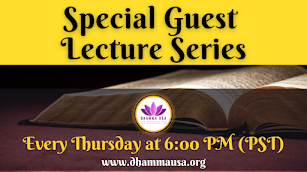Navigating Happiness: A Buddhist Perspective on Inner Peace and Emotional Well-being
By Nivitigala Sumitta (Bhante Sumitta)
This essay explores Buddhism's approach to happiness, emphasizing that true well-being stems from inner mental states rather than external circumstances. It highlights the Buddhist focus on inner peace, mindfulness, and compassion as essential for achieving lasting happiness. The essay contrasts mundane, fleeting happiness with supramundane happiness, which arises from spiritual insight and ethical living. It examines the role of mindfulness in cultivating a deeper sense of contentment and the practical aspects of achieving happiness through effort, resource management, and balanced living. The analysis also considers the challenges of applying these teachings in the modern world, suggesting that while Buddhism offers profound insights, integrating its principles with contemporary realities is crucial for a holistic approach to happiness.
Introduction
Buddhism, originating with Siddhartha Gautama—the Buddha—over 2,500 years ago, offers a distinctive perspective on happiness that centers on inner mental states rather than external circumstances. Unlike many spiritual traditions that emphasize worship of a deity, Buddhism focuses on personal enlightenment achieved through ethical living and mental discipline. This essay explores how Buddhism defines and approaches happiness, highlighting its emphasis on inner peace, the role of mindfulness and compassion, and the practical implications of these teachings for contemporary life.
Buddhist Understanding of Happiness
In Buddhism, happiness is understood as an emotional state characterized by joy, serenity, satisfaction, and fulfillment. However, the path to achieving genuine happiness is not straightforward. The Buddhist approach involves a deep understanding of the nature of suffering and the development of mental discipline through practices like meditation and mindfulness. The Eightfold Path, central to Buddhist practice, provides a framework for cultivating qualities such as ethical conduct, mental discipline, and wisdom, which are essential for lasting happiness.
The distinction between immediate and lasting happiness is crucial in Buddhist thought. Immediate happiness is often fleeting and dependent on external factors, while true happiness is seen as a result of long-term actions and emotional states. Buddhism teaches that both positive and negative emotions are part of human experience, but lasting happiness comes from cultivating positive emotions and reducing suffering through mental and emotional training. By overcoming detrimental emotions such as greed and hatred, individuals can achieve a more stable and enduring sense of contentment.
The Role of Mindfulness and Compassion
Buddhism distinguishes between mundane and supramundane happiness. Mundane happiness is derived from sensory pleasures and temporary experiences, while supramundane happiness arises from spiritual insight and the realization of the true nature of reality. The concept of dukkha, or suffering, is central to Buddhist teachings and highlights that all conditioned experiences are transient. By practicing mindfulness and detaching from transient desires, individuals can move beyond superficial forms of happiness to attain a deeper, more enduring sense of well-being.
Mindfulness plays a critical role in this process. It involves maintaining a conscious awareness of one's thoughts, feelings, and actions, which helps individuals remain grounded in the present moment and avoid being overwhelmed by cravings and distractions. Compassion, another core aspect of Buddhist practice, involves cultivating love and empathy for others, which can significantly contribute to one's own happiness. The Buddha’s teachings emphasize that true happiness is achieved not just through personal contentment but also through caring for the well-being of others.
Practical Aspects of Achieving Happiness
The practical requirements for achieving happiness in Buddhism include diligent effort, proper management of resources, good friendships, and a balanced lifestyle. These aspects ensure material and social stability while fostering inner contentment. Effort involves actively pursuing personal growth and ethical conduct, while resource management and good friendships contribute to a stable and supportive environment. A balanced lifestyle helps prevent extremes of extravagance or stinginess, promoting a sense of well-being and satisfaction.
However, the application of these principles can be challenging, particularly in the context of modern life. Issues such as economic inequality, social injustice, and mental health challenges complicate the straightforward application of Buddhist teachings. While Buddhism offers valuable insights into achieving deeper happiness through internal practices, addressing these external factors is also essential for a comprehensive approach to well-being.
Critical Analysis
The Buddhist perspective on happiness provides a profound framework for understanding well-being through inner mental states and ethical living. The focus on mental discipline and compassion offers a holistic approach to happiness that contrasts with materialistic or hedonistic perspectives. The distinction between mundane and supramundane happiness underscores the importance of spiritual insight in achieving lasting contentment.
Nevertheless, the practical application of Buddhist teachings may require adaptation to address contemporary challenges. The emphasis on detachment from desires and the reduction of negative emotions, while valuable, may be challenging to implement fully in a complex and interconnected world. Additionally, the practical requirements for happiness, such as effort and balanced living, may not fully address the external factors that impact well-being.
In conclusion, Buddhism offers a rich and insightful perspective on happiness that emphasizes inner peace, mindfulness, and compassion. While the teachings provide valuable guidance for achieving lasting contentment, their practical application may need to be adjusted to accommodate the realities of modern life. By integrating Buddhist principles with a broader understanding of social and personal challenges, individuals can navigate the pursuit of happiness in a more holistic and effective manner.
References
Bhikkhu Bodhi. In the Buddha’s Words: An Anthology of Discourses from the Pali Canon. Boston: Wisdom Publications, 2005.
Bloomfield, Paul. The Virtues of Happiness: A Theory of the Good Life. New York: Oxford University Press, 2014.
Gethin, R. The Foundations of Buddhism. New York: Oxford University Press, 1998.
Guang Xing. “Filial Piety in Early Buddhism.” Journal of Buddhist Ethics 12 (2005): 82–106. http://blogs.dickinson.edu/buddhistethics/2010/04/27/filialpiety-in-early-buddhism.
Hasselberger, William. “Paul Bloomfield, The Virtues of Happiness: A Theory of the Good Life (New York: Oxford University Press, 2014), pp. vii+232.” Utilitas 27, no. 2 (2015): 257–262.
Karunadasa, Yakupitiyage. Early Buddhist Teachings. Simon and Schuster, 2018.
Laumakis, Stephen J. An Introduction to Buddhist Philosophy. Cambridge: Cambridge University Press, 2008.
Karunadasa, Y. Early Buddhist Teachings: The Middle Position in Theory and Practice. Hong Kong: Centre of Buddhist Studies of the University of Hong Kong, 2021.
Lawmakers, Stephen J. Introduction to Buddhist Philosophy. England: Cambridge University Press, 2008.
Lama, Dalai. In the Buddha's Words: An Anthology of Discourses from the Pali Canon. Simon and Schuster, 2005.
Mattes, J. “Buddhism without Negativity Bias: Dukkha, Taṇhā, and Modern Psychology.” Manuscript submitted for publication. https://www.mat.univie.ac.at/~mattes/PDF/dukkha-tanha.pdf (2018).
Nguyen, Hang TM, and Hoang V. Nguyen. “Positive and Negative Emotions and Nonattachment in Vietnamese Buddhists.” Asian Journal of Social Science Studies 3, no. 1 (2018): 32–45.
Skorupski, Tadeusz. “The Buddhist Permutations of Consciousness.” Esoteric Buddhist Studies: Identity and Diversity (2008): 155–170.
Yeh, Theresa Der-lan. “The Way to Peace: A Buddhist Perspective.” International Journal of Peace Studies (2006): 91–112.






























0 comments:
Post a Comment
Your comments and feedback are very helpful to us in improving our posts. We really appreciate your time. Thank you!
Dhamma USA Team.